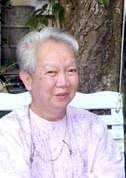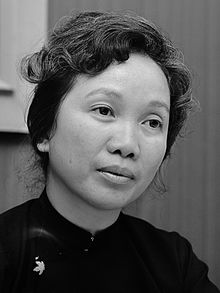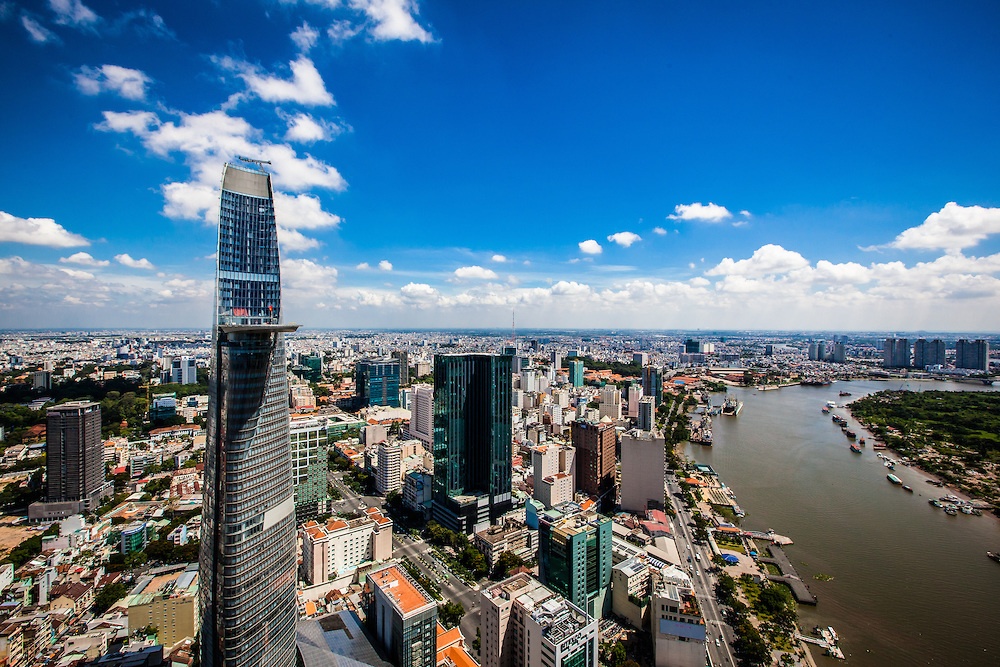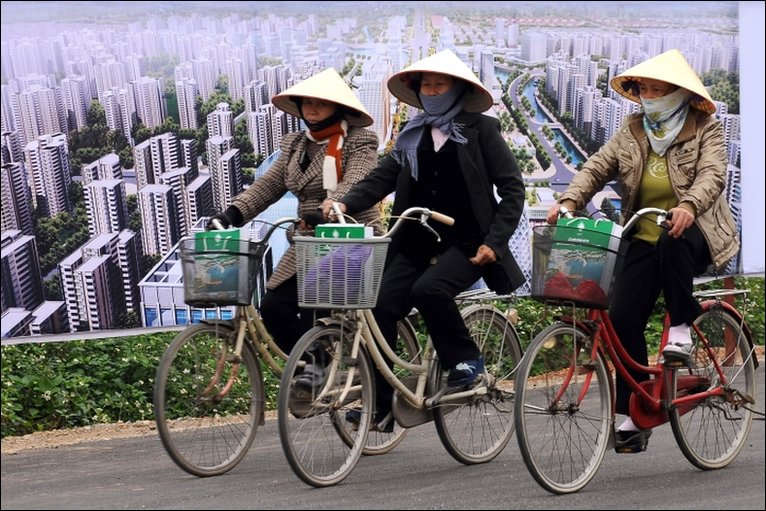In 1995, I returned to Vietnam for the 20th anniversary of the Fall of Saigon. During that trip, I made it a point to interview as many people as possible about their country–including former Communist Viet Cong cadres. What I heard was surprising. They were not happy with this new Viet Nam.
They still are not. One of the most interesting interviews I had was with Dr. Dương Quỳnh Hoa, one of the founders in 1960 of the National Liberation Front, otherwise known as the Viet Cong. We met at the Saigon Center of Pediatrics, Development and Health in Ho Chi Minh City of which she was the director.
Dr. Duong passed away in 2006, 11 years after we talked. I wonder what she would have thought of the extravagant “Liberation Celebration” staged this week by the Communist Vietnamese government. In 1995, she refused to attend any of the celebrations, citing corruption and failed policies. I suspect she would have done this same this week.
My story, which appeared May 14, 1995, follows. (Ron Yates)
INCOMPLETE REVOLUTION VIET CONG FOUNDER: MONEY OVERSHADOWS IDEALS
Dr. Doung Qunyh Hoa is a slight, soft-spoken, gray-haired woman of 64 years-the kind you might choose as a grandmother if such choices were left to individuals and not to fate.
But don’t be fooled by appearances. Hoa is as tough and shrewd as they come.

She had to be. As one of the 16 founders of the National Liberation Front in 1960-a group the world would come to know as the Communist Viet Cong-Hoa spent several months in a South Vietnamese jail and more than eight years in the jungles of Vietnam.
During that time, she hid from U.S. search-and-destroy missions, experienced the terror of B-52 carpet bombings, and lost a child to the diseases that accompany jungle life.
Today, 20 years after the war ended, you would think Hoa would be a mellow revolutionary-happy with the way Vietnam is evolving; happy with the peace it now enjoys; happy with the country’s decision to encourage foreign investment and its attempt to create a market economy.
But she’s not.
In fact, since the war ended on April 30, 1975, Hoa has become so disenchanted that she has resigned from the Communist Party. She also refused an invitation to attend a gala reception at the Hall of The People to celebrate the 20th anniversary of the defeat of South Vietnam.
Why all the rancor and acrimony? After all, didn’t Hoa and the Viet Cong win the war?
“We won, but I don’t feel we have achieved our goals. There have been too many mistakes,” said Hoa, sitting in her office at the Saigon Center of Pediatrics, Development, and Health in Ho Chi Minh City, of which she is the director.
One mistake, she insists, was treating the people of South Vietnam like losers and the people of the North as winners. As a result, there were too many re-education camps, too much punishment, and not enough healing.
“Without the people of South Vietnam, Hanoi would never have won the war,” Hoa said. “It was not the forces of North Vietnam that won the war. It was the guerrillas and their supporters in the South.
“Our people are not happy. Yes, we have lots of foreign investment. And that’s good. I am all for that. I told (Communist Party Secretary-General) Do Muoi that you have to open the country . . . to join the global economy. If you don’t, you will have another revolution on your hands. But you cannot open only economically. You must open politically too.”
And therein lies the problem, she said: Those in power in Hanoi fear losing control of the country if there is too much Vietnamese-style glasnost and perestroika.
“I put a question to the leaders in Hanoi,” Hoa said. ” `What is your final goal–the final goal of the revolution? Is it the happiness of the people or power?’ Then I answered the question. `I think it is power.’ There is too little regard for human rights in Vietnam today.”

Power, Hoa insists, breeds corruption-especially when it is almost absolute power and it is mixed with the seductive river of foreign capital flowing into the country.
“All revolution promises to teach government to be honest,” Hoa said. “But when humanitarian aid comes into Vietnam, the leaders in Hanoi don’t think of it in terms of aid. Instead, they think of it in terms of dollars. They think the duty of humanitarian aid is to bring in dollars, not help for the people. Does this money go to the people? I am not so sure. And we must be sure that the people benefit-not those in power.”
Nowhere is the flood of dollars, yen, marks, and francs more evident than in the former Saigon, a city the French dubbed the “Pearl of the Orient” when they invaded in 1859.
Since 1975, the “pearl” has been dulled by capitalistic inactivity. But now, with the U.S. economic embargo lifted, the great city’s money machine is on the move again.
Its legendary hustle-not seen since the height of the war years when Tu Do Street (now called Dong Khoi) was a busy warren of bars, brothels, and bistros-is back. And so is the thirst for dollars and all the things they can buy.
Granted, the hustle in 1995 is a more sophisticated, sanitized version than the one that permeated much of Saigon in 1975. Back then there was a perverseness to the place unrivaled anywhere else in Asia.
It wasn’t just the thousands of Vietnamese bar girls, pimps, pickpockets and thieves. It was also the foreign element-ex-GIs who spent their pension checks in the city’s countless bars and brothels; the soldiers of fortune and would-be soldiers of fortune who regaled anybody who would listen with greatly embellished tales of valor in the bush; the con men; the drug dealers; the derelicts and castoffs from an ill-fated war in a land few of them really took the time to understand.
Today, the Saigon hustle moves to a different beat.
Instead of grubby soldiers of fortune, retired spies, and military castoffs, the foreign presence today consists largely of well-scrubbed men and women in their 20s and 30s.
Instead of roaming the city armed with war stories, Saigon’s new foreign inhabitants-many of them Vietnamese who have returned from the U.S.-are armed with MBAs and a broad range of business skills.
And instead of swilling boilermakers in dingy little gin mills with names like Mimi’s and Mama-san’s that once lined Tu Do Street, they gather to sip Cinzano on the rocks at the Q-Bar-a spotless place nestled in the underside of Saigon’s 95-year-old alabaster municipal theater in Lam Son Square.
It’s a place the denizens of Saigon in 1975 would have scoffed at because of its conspicuous respectability. Indeed, most of those sitting inside-foreigners and Vietnamese alike-seem blissfully unaware of what happened in the city 20 years ago. For them, Saigon is not a city steeped in conflict and upheaval; it’s a place where you can get rich by cutting deals and signing contracts.
And while people like Hoa don’t feel it’s necessary to dwell on the past, she wonders about the values being taught and learned in this new Saigon.
“The tragedy of war is the ultimate loss of moral values,” Hoa said. “During a war everything is scarce and nobody has anything. After a war everybody wants to consume. Vietnam is like that today. All the young people in Saigon think about today are motorcycles, television sets, fashion and rock and roll. It is turning into another Bangkok.”
Hoa’s assessment is not far off. Saigon today is a city in constant motion-a sea of Honda motorbikes, bicycles and cars cascading down streets littered with men, women, and children selling everything from pirated copies of Graham Greene’s “Quiet American” (still considered the quintessential novel of Vietnam) to cigarette lighters made from old M-16 shell casings. Tiny stalls are overflowing with everything from T-shirts and TV sets to compact discs and computer software.

Vietnamese yuppies equipped with cellular phones, pagers, and new motorbikes are almost as ubiquitous as the city’s gaunt cyclo drivers, who eke out a living pedaling American and European tourists around central Saigon for the equivalent of 50 cents a mile.
Few of the city’s young have any recollection of the war that Hoa still remembers so vividly and that visiting Americans seem constantly to be asking about.
“I was only 3 when the war ended,” said La Dang Thao, a university student standing in front of the hulking black statue of Ho Chi Minh in the plaza fronting the Saigon People’s Committee building. “I only know what my parents told me. They said it was very bad in the 1960s and 1970s. But for me, it is meaningless. For me, the war is only something in a book.”
Thao paused a moment and turned to several of his fellow students-all studying economics at a Saigon university. A short discussion ensued and then Thao turned back.
“You see, what is important today is the economy of Vietnam, the infrastructure of the country,” he said. “We must build a country with an open market, where everybody has an opportunity to get rich. Like in America. It really does no good to dwell on the past. We need to encourage investment from America, not guilt.”
For Hung Pham, a 49-year-old former South Vietnamese soldier, guilt of any kind is the furthest thing from his mind.
Pham is one of Saigon’s newest collection of capitalists-a manufacturer, a marketing expert, a salesman, and a public relations person all rolled into one.
The products Pham turns out are an eclectic collection of miniature airplanes, helicopters, lobsters, cars, motorbikes, even Eiffel Towers-all made from old Coca-Cola and Pepsi Cola cans.
On just about every street corner of Saigon, you can find Pham’s products-or those of his competitors. If there is one thing true about capitalism anywhere, success always breeds duplication.
Pham started his business about five years ago, but only in the last year has it really begun to take off.
“Business is getting better because foreigners are coming to Saigon as they did before 1975,” said Pham, who sells his metallic creations for $2 to $5 each.
Also arriving in Saigon by the thousands each day are poor families from the Mekong Delta. They cram leaky wooden sampans and navigate the putrid, black estuaries of the Saigon River until they find a place to tie up.
Saigon’s official population is put at about 3 million, but with “unofficial residents” arriving each day-like My Ahn, her husband and their four children-most estimates put the city’s population at about 5 million.
From the bow of a boat ladened with bananas, mangoes, and green papaya, Ahn conducts business, selling fruit to a local restaurant owner.
“We live here on the river maybe half the year,” Ahn says. “It’s the only way we can survive.”
Now 38, Ahn was an 18-year-old Viet Cong soldier in 1975. After the war, she married her commanding officer, now 44, and put aside her AK-47 to raise a family.
“Life is OK,” she said, arranging bunches of bananas. “But it is not as good as we all thought it was going to be after liberation.”
For Ahn and the thousands of other former Viet Cong who slogged through the mine-strewn rice paddies of the Mekong Delta, central Saigon-with its Q-Bar, its cellular phones and its wheeling and dealing-is a place beyond comprehension.

“I never go there,” she said. Then laughing, she added: “I am only a little VC. Those people are all capitalists.”
It’s one of the ironies of Vietnam these days that those like My Ahn, who fought and helped win the war against the former South Vietnamese government and its American allies, are also those who seem to be benefiting least from the outcome. It’s a fact that has not eluded people like Hoa.
“I am not deceived,” Hoa said. “I have seen the reality and the reality is this: In spite of our victory, we are paying a huge price because of the ignorance and incompetence of our leaders. Today we feel empty. The fruits of victory have not been evenly distributed. I have been a communist all my life, but now I’ve seen the realities of Communism, and it is a failure — mismanagement, corruption, privilege, repression. My ideals are gone.
“We are a nation that still suffers. Our children are suffering. Half of them are malnourished. The next two years will be very important for Vietnam. It will be a time of choice for us. The leaders in Hanoi must make sure the nation’s economic opening is accompanied by political opening. If not, the revolution will have been for nothing.”

